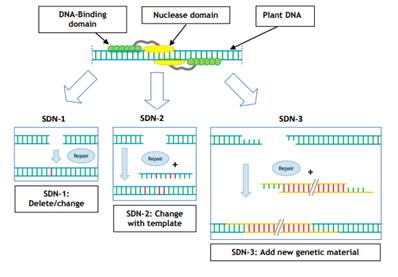Change in Rules for Some Gene-Edited Plants and Organisms
- 02 Apr 2022
The Union Ministry of Environment, Forests and Climate Change (MoEFCC) has notified key change in rules that will allow genome-edited plants or organisms without any “foreign” genes to be subjected to a different regulatory process than the one applied to genetically engineered products.
The changes will exempt two categories of genome-edited products — in which genes are tweaked (Technique- SDN 1 & SDN 2) but not inserted from another organism (Technique-SDN 3) — from being treated as transgenic products.

Process of Gene-editing
(Image Source: nbtplatform.org)
Finer Details
So, now who will regulate SDN1 and SDN 2 Gene-edited Plants?
- Now, SDN1/SDN2 category plants will be initially regulated by Institutional Biosafety Committee (IBSC) / Review Committee on Genetic Manipulation (RCGM) under EPA Rules, 1989 and subsequently under the ‘Seed Act’ under the Ministry of Agriculture and Farmers Welfare—a unique duel regulatory system ensuring biosafety and benefits of technology.
Benefits for India after the recent Rule Change
- With the notified change, India now has a separate regulatory process for such technologies that takes them out of the purview of Genetic Engineering Appraisal Committee or GEAC (It is the final technical body that certifies a GM product as safe for commercial release).
- SDN1 and SDN2 genome-edited products free from exogenous introduced DNA be exempted from biosafety assessment in pursuance of rule 20 of the Manufacture, Use, Import, Export and Storage of Hazardous Microorganisms/Genetically engineered Organisms or Cells Rules 1989.
Some Key Concepts
SDN Technology
- SDN stands for Site-directed Nuclease and refers to the practice of cleaving DNA strands to effect the subsequent genome editing.
- The goal of SDN technology is to take advantage of the targeted DNA break and the host’s natural repair mechanisms to introduce specific small changes at the site of the DNA break. The change can either be a small deletion, a substitution or the addition of a number of nucleotides. Such targeted edits result in a new and desired characteristic, such as enhanced nutrient uptake or decreased production of allergens.
Categories of Gene-editing
- There are three categories of gene-editing: SDN1, SDN2 and SDN3.
- SDN1 & SDN2: The first two (SDN1 & SDN2), which largely involve “knocking off” or “overexpressing” certain traits in a genome without any insertion of gene material from outside, will be covered by the new changes.
- SDN3: The third (SDN3), which involves insertion of foreign genes, will be treated as GMO.
Benefits of SDN Technology
- Site-Directed Nuclease technology can be used to precisely remove undesirable traits in plants –
- such as anti-nutrients or allergens, in order to reduce environmental pollution or to enhance the
- nutritional value of a crop.
- It can also modify certain existing characteristics in a plant to respond to consumer needs such as enhanced shelf-life and improved taste or texture.
How Genome Edited Plants differ from Genetically Modified Organisms?
- Genome edited plants allow for the generation of functional mutations in the recipient genome at specific targets.
- In the case of SDN1 and SDN2, yield plants are free from any foreign DNA and remain indistinguishable from conventionally bred crops.
|
GM Crops in India
|




